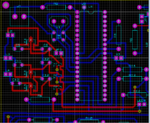sonar_abhi
Member level 1
Hello Guys,
I am making a simple program to test the pcb I designed.
The program is to turn on a led at PORTC.F3. The PIC16f877A works fine in the development board but it wont work in the actual pcb. I have checked the connections and they seem to be fine.
I dont know what is wrong. I am posting a snapshot of the PCB. Please help.

I am making a simple program to test the pcb I designed.
The program is to turn on a led at PORTC.F3. The PIC16f877A works fine in the development board but it wont work in the actual pcb. I have checked the connections and they seem to be fine.
I dont know what is wrong. I am posting a snapshot of the PCB. Please help.
